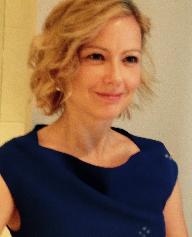 Prof. Niamh Stack from Glasgow University visited the European Talent Centre Budapest in order to take part at the EGIFT workshop in November. She spoke about the modul 4 - about the teaching strategies - which was written by her and her colleagues.
Prof. Niamh Stack from Glasgow University visited the European Talent Centre Budapest in order to take part at the EGIFT workshop in November. She spoke about the modul 4 - about the teaching strategies - which was written by her and her colleagues.
Who is the target audience of EGIFT programme?
The main intent of this programme was to provide free online resources for teachers and professionals in the field of talent support. Many teachers may not able to travel to Talent Centres for further educations. It often happens that students in their class demonstrate high ability, but the teachers don’t know exactly how to challenge them. These online resources are of special importance for them. We were clear on our intent to bring together international partners that have different expertise so that EGIFT would be available in different countries with input of all these international partners.
Why is it challenging to design a programme for such a wide audience, for teachers and professionals coming from different countries and different cultures?
The first and very practical challenge that we faced was the language itself. One of our longest conversation was about the programme’s language then we concluded that it would be primarily in English. It is an unfortunate that it could create automatic barriers for many people, but we are hopeful that after the first stage of the project we can find additional funding to get the materials translated into some other languages. Particularly, many schools in our areas may not have access to a kind of training we can offer, and some schools may not have teachers who speak English. We believe that it has been only the first step and certainly there will be several practical challenges to make the programme more complex and accessible for anyone in the future.
What other challenges did you have to face during designing the programme?
The second challenge is to work within an international context. The context is so important to learning since we have different legislations, we have different policies and certainly we have different definitions of what we mean by highly able. We absolutely wanted to give a flavour of that international perspective. It was undoubtedly challenging to make the courses coherent for those who try to understand it in different countries.
How can you summarize the main elements of your module in EGIFT programme?
We were responsible for the fourth part of the programme which was about teaching strategies. When we were talking about teaching strategies we wanted to first talk about the fact that no one strategy offers the solution for challenging gifted and talented learners. We need to take account of the individual learner, the context and the resources available. Interconnectedness of learning is about the fact that you can’t detach teaching from learning and you can’t detach learning from the child and their environment.
Would you give a specific example of interconnectedness?
For example, if a child comes from a family where there is extreme poverty it can impair the child’s learning in the classroom and his or her ability to engage in a challenge that you might want to provide. You can have excellent teaching strategies but if the learners are not ready, there are distractions and then it falls apart.
Are there any basic principles in relation to the educational material and your practice?
There are some basic principles that Prof. Margaret Sutherland (co-writer of the module) and me always follow. We abide one of our overarching principles which is about the fact that we need to capture, appreciate and celebrate differences instead of seeing it as something to be excluded or discriminated. It is challenging, and we should rise to the challenge. We believe that it is crucial to engage, motivate and excite gifted learners. We want them to feel constantly energized.
What can the ‘Scottish model’ bring to the programme?
What Scottish model brings to the programme is Scotland’s commitment to inclusive education. For us it means that we need to demonstrate what every day classroom interaction can look like for highly able people. By increasing the opportunities for challenge in the classroom we will not only satisfy the needs of gifted but also that of all children in the classroom.” Rising tide raises all ships” Anything you do that is good for highly able pupils will also be good for other pupils. They just may engage slightly differently.
What are your expectations concerning EGIFT?
You left the hardest question for the last. In our view, EGIFT will be a platform that is the first stepping stone where we want to go. So, it will be a platform for which we have gathered resources, different expertise, case studies, and we have gathered really practical information for teachers in the classroom. The first step of the next stage. Once we have a platform, we can continue to build it by involving more partners, and for further development we can get feedback from teachers and professionals for whom EGIFT was designed.